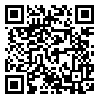Volume 18, Issue 5 (2018)
MCEJ 2018, 18(5): 71-78 |
Back to browse issues page
Download citation:
BibTeX | RIS | EndNote | Medlars | ProCite | Reference Manager | RefWorks
Send citation to:



BibTeX | RIS | EndNote | Medlars | ProCite | Reference Manager | RefWorks
Send citation to:
Rezaei Farei A. Assessment of Optimized Face Pressure of Mechanized Tunneling in Granular Soils by Numerical Modelling. MCEJ 2018; 18 (5) :71-78
URL: http://mcej.modares.ac.ir/article-16-20264-en.html
URL: http://mcej.modares.ac.ir/article-16-20264-en.html
1- assistant professor, faculty of engineering, Azarbaijan Shahid Madani University, Tabriz, Iran
Abstract: (8931 Views)
Estimating the pressure required to maintain the tunnel face is one of the most important factors regarding safe and optimal excavation using mechanized tunnel boring machines in urban areas. Applying a pressure more or less than the balance to the face would cause collapse and blow out in the tunnel face respectively. This pressure depends on several factors such as soil type and its engineering specifications, underground water conditions, excavation method, amount of surcharge and tunnel section area. In this paper, the influence of soil elasticity modulus, friction angle and underground water condition on the optimum amount of face pressure in granular soils were studied. For this purpose, a 3D finite element model was used employing the ABAQUS software (Ver. 6.14). The model takes into account relevant components of the construction process as separate components in the model (including: soil and ground water, tunnel lining and tail void grouting). Twenty-four steps have been performed according to the real construction sequences to achieve realistic model’s results. As regards, there are too many parameters involved in mechanized excavation, the geometry of tunnel, lining segments, injection grout and the surrounding soil properties are adapted from the under construction of Tabriz urban railway line 2 project. The tunnel surrounding soil above the ground water level were discretized by 8-node first order fully integrated continuum elements (C3D8). The tunnel lining and TBM shield were simulated by S8 shell elements. The soil under the ground water level and the grout material were modelled as saturated porous media using pore pressure elements (C3D8P). The soil behaviour was assumed to be governed by an elastic perfectly-plastic constitutive relation based on the Mohr–Coulomb criterion with a non-associative flow rule. Tunnel lining and TBM shield were simulated as an elastic behaviour. The ingress of ground water into the tunnel was not considered in this study. The paper gives a detailed description of the model components and the stepwise procedure to simulate the construction process. More than 70 3D models were analyzed and optimum pressure in the tunnel face was determined through measuring the amount of induced average displacement in the tunnel face. For various elasticity modulus, internal friction angle and underground water conditions different values of face pressure were applied in tunnel face and corresponding average tunnel face displacement were measured for each state. Results show that elasticity modulus of soil has a remarkable effect on the amount of the optimized face pressure and for minimize the tunnel face displacement, elasticity modulus should be considered in calculation of the applied face pressure. As the soil elasticity modulus increase the value of optimum face pressure decreases. Also the face pressure was calculated using analytical and experimental methods and the results were compared with the obtained optimum pressure. The results are in good agreement with those obtained from the COB method. In the cases with low elasticity modulus (less than 20 MPa in this study) the COB method obtained face pressures are less than optimal pressure resulted in this study. This difference increase with lowering of ground water level.
Article Type: Original Manuscript |
Subject:
Earthquake
Received: 2017/02/26 | Accepted: 2017/12/30 | Published: 2019/02/15
Received: 2017/02/26 | Accepted: 2017/12/30 | Published: 2019/02/15
| Rights and permissions | |
 |
This work is licensed under a Creative Commons Attribution-NonCommercial 4.0 International License. |








